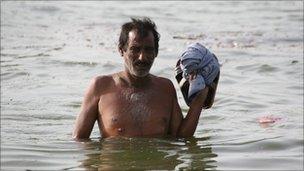Pakistan floods crisis is far from over, says Oxfam
- Published

Oxfam says hundreds of thousands of people remain homeless six months after the floods
Six months after Pakistan's worst monsoon floods in 80 years, Oxfam says the crisis is far from over and could even get worse.
The UK-based agency says malnutrition levels in the south have soared, and the aid community has only "scratched the surface of human need".
At least 170,000 people remain in relief camps and swathes of land are still under foul water in the south.
Pakistan's government says it is extending emergency relief efforts.
The UN appeal for $2bn (£1.26bn) to rebuild Pakistan remains only 56% funded.
'Immense disaster'
Oxfam's report, Six months into the floods, external, warns that large numbers of people still need help.
Neva Khan, head of the aid agency in Pakistan, said: "Oxfam is currently helping nearly 1.9 million people - one of our biggest programmes worldwide - but this is dwarfed by the number of people who are in need.
"The aid community has done a tremendous amount, but given the immense scale of this disaster we have only scratched the surface."
Amid freezing winter temperatures, there were more than 200,000 cases of chest infections such as pneumonia reported in the second week of January alone, says Oxfam.

Between 14 and 20 million people were affected by the floods
The UN says 170,000 flood victims remain in relief camps.
Oxfam says the total number of homeless people is much higher.
The aid agency also says that malnutrition levels remain stubbornly high.
And it warns that another food crisis looms because so many crops were lost in the disaster and most farmers missed the next planting season.
Emergency relief operations, which are still ongoing in parts of the southern provinces of Sindh and Balochistan, had been due to wind up by the end of this month.
But on Wednesday, Pakistan's National Disaster Management Authority (NDMA) said such operations would continue in the affected areas until 31 March.
The extension would cover four districts of Sindh and one in Balochistan, where people were still living in camps, said NDMA spokesman Ahmad Kamal.
There were now fewer than 230 relief camps remaining, down from more than 5,000 at the height of the disaster, he added.
"We expect 153,000 more people to leave camps by March when weather will improve and there will be more work in the fields," he said.
Although the death toll from last summer's deluge was relatively low - claiming about 1,750 lives - between 14 and 20 million people were affected.
The floods started in the mountainous north and surged south, destroying 1.2m homes and damaging about 14% of Pakistan's land under cultivation.
- Published3 December 2010
- Published2 December 2010
- Published30 November 2010